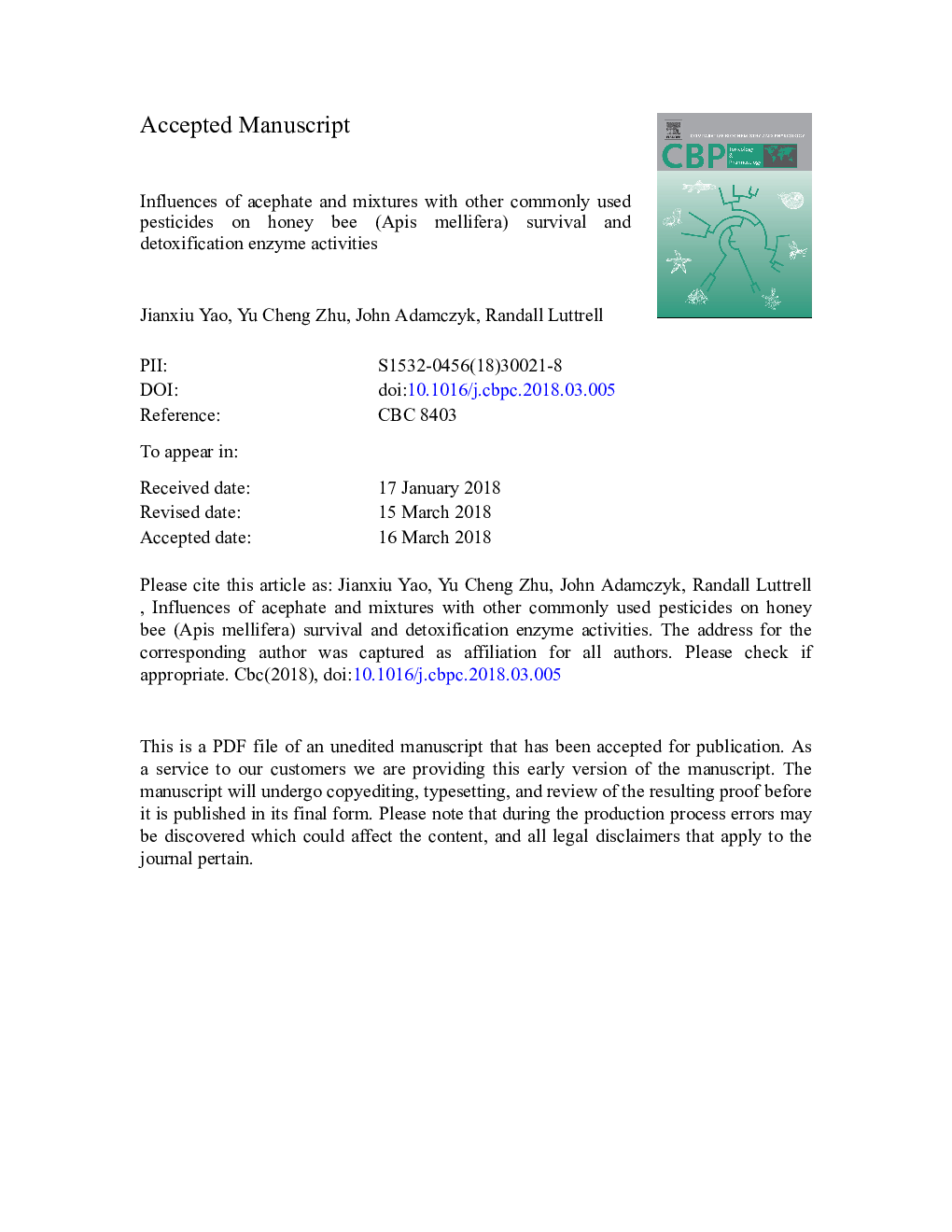| کد مقاله | کد نشریه | سال انتشار | مقاله انگلیسی | نسخه تمام متن |
|---|---|---|---|---|
| 8318981 | 1539254 | 2018 | 33 صفحه PDF | دانلود رایگان |
عنوان انگلیسی مقاله ISI
Influences of acephate and mixtures with other commonly used pesticides on honey bee (Apis mellifera) survival and detoxification enzyme activities
دانلود مقاله + سفارش ترجمه
دانلود مقاله ISI انگلیسی
رایگان برای ایرانیان
کلمات کلیدی
موضوعات مرتبط
علوم زیستی و بیوفناوری
بیوشیمی، ژنتیک و زیست شناسی مولکولی
زیست شیمی
پیش نمایش صفحه اول مقاله

چکیده انگلیسی
Acephate (organophosphate) is frequently used to control piercing/sucking insects in field crops in southern United States, which may pose a risk to honey bees. In this study, toxicity of acephate (formulation Bracket®97) was examined in honey bees through feeding treatments with sublethal (pollen residue level: 0.168â¯mg/L) and median-lethal (LC50: 6.97â¯mg/L) concentrations. Results indicated that adult bees treated with acephate at residue concentration did not show significant increase in mortality, but esterase activity was significantly suppressed. Similarly, bees treated with binary mixtures of acephate with six formulated pesticides (all at residue dose) consistently showed lower esterase activity and body weight. Clothianidin, λ-cyhalothrin, oxamyl, tetraconazole, and chlorpyrifos may interact with acephate significantly to reduce body weight in treated bees. The dose response data (LC50: 6.97â¯mg/L) revealed a relatively higher tolerance to acephate in Stoneville bee population (USA) than populations elsewhere, although in general the population is still very sensitive to the organophosphate. In addition to killing 50% of the treated bees acephate (6.97â¯mg/L) inhibited 79.9%, 20.4%, and 29.4% of esterase, Glutathione S-transferase (GST), and acetylcholinesterase (AChE) activities, respectively, in survivors after feeding treatment for 48â¯h. However, P450 activity was elevated 20% in bees exposed to acephate for 48â¯h. Even though feeding on sublethal acephate did not kill honey bees directly, chronic toxicity to honey bee was noticeable in body weight loss and esterase suppression, and its potential risk of synergistic interactions with other formulated pesticides should not be ignored.
ناشر
Database: Elsevier - ScienceDirect (ساینس دایرکت)
Journal: Comparative Biochemistry and Physiology Part C: Toxicology & Pharmacology - Volume 209, July 2018, Pages 9-17
Journal: Comparative Biochemistry and Physiology Part C: Toxicology & Pharmacology - Volume 209, July 2018, Pages 9-17
نویسندگان
Jianxiu Yao, Yu Cheng Zhu, John Adamczyk, Randall Luttrell,